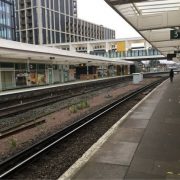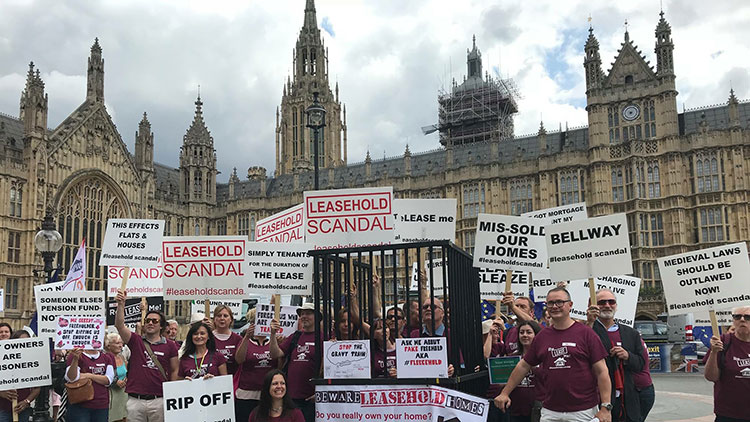
National Leasehold Campaign protest in July at Westminster Pic: NCL
In the latest piece in our series on the housing crisis, Sam Hancock looks at how leasehold properties have soared in the past decade, with many freeholders now living overseas
As demands for increased housing in London’s southern and eastern boroughs continue to grow, so too does the concern that the majority of properties now available to potential homeowners are leasehold.
Almost 60 percent of residential property transactions in England and Wales in 2017 were leasehold. Nearly all flats are sold as leasehold as the capital continues to see a huge rise in new builds and flat conversions.
The growth is fuelled by the demand for affordable housing for new homeowners, given that the majority of first time buyers in the capital cannot afford to buy houses outright
Sebastian O’Kelly, of the Leasehold Knowledge Partnership (LKP) think tank, said London residents are “being ripped off” when they buy leasehold properties which are “being built like never before.”
He said: “Far too many leaseholds are owned by anonymous freeholders based offshore. Enough of this. It’s bad enough young people aren’t getting on to the property ladder and then when they are – they’re being ripped off.”
Read our earlier pieces in the housing crisis series:
- New scheme to help those in temporary accomodation
- Homeless sent as far as Leicester in search for temporary accomodation
- Eros House: the story of just one block of flats
Data from The Land Registry shows that leasehold sales now dominate the property markets in Tower Hamlets, Hackney and Lewisham.
According to the House of Commons Library’s annual “leasehold reform” report, “owners of long-term leasehold properties do not necessarily appreciate that, although they are owner-occupiers, they are in a landlord and tenant relationship with the freeholder (landlord).”
Tower Hamlets in particular showed the serious lack of residents who own their own homes; 92 percent of the total properties sold in 2018 were bought on a leasehold basis.
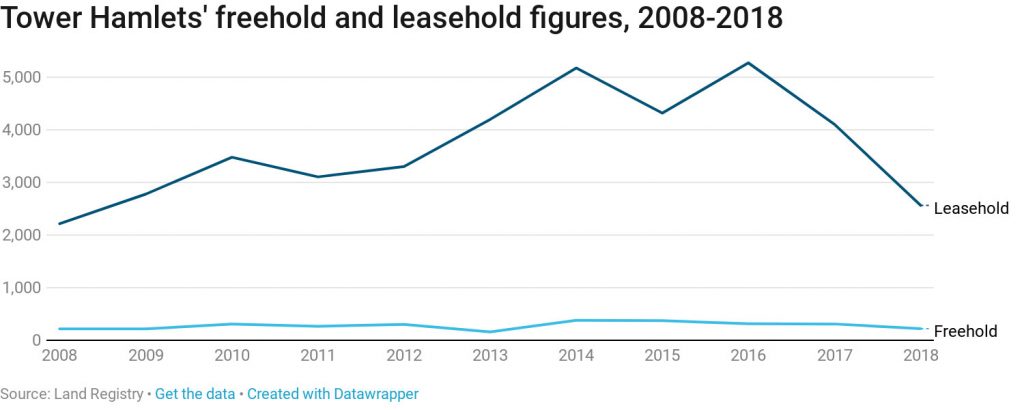
Graph: Sam Hancock
O’Kelly said Tower Hamlets has “the second largest leasehold rate within inner London, just behind Westminster.”
He also said: “We’re really concerned about this issue, because leaseholds are being built like never before and ultimately it’s a very uncertain tenure. People who own these homes are vulnerable in any dispute with the freeholder, who normally only has to have a minimal financial stake in the building. Effectively, it is a licence to print money and a licence for exploitative behaviour.”
Like Tower Hamlets, the amount of leasehold properties sold in Hackney over the past 10 years has been disproportionately higher than the amount of freehold homes.
Almost 1,500 homes were sold as leasehold in Hackney this year, compared to the 400 freehold properties sold in the same time.
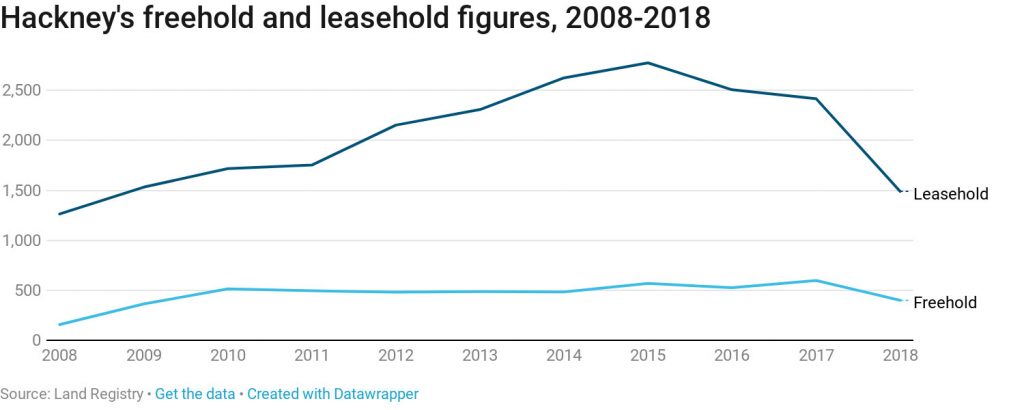
Graph: Sam Hancock
Martin Boyd, chair of the LKP, said: “The leasehold market continues to grow as more homes are built as flats and as more developers see the opportunity for additional profit streams from selling houses as leasehold. The government has finally committed to stop builders selling new build houses as leasehold. For flats the only way we will move away from leasehold sales is when the government completes their review of commonhold legislation. A commonhold type system is now used by almost every other country around the globe.”
Commonhold is a fairly new type of property ownership and acts as an alternative to the long-term leasehold system. A commonhold can only be created out of freehold land, or a freehold building, and comes into effect when the land is registered at the Land Registry as a commonhold.
In July, The Law Commission put forward proposals to the government to tackle the problems leasehold homeowners face. One of their suggestions was to amend leasehold contracts so that there is “no minimum period of lease ownership, reducing delay and costs for leaseholders.”
Law Commissioner, Professor Nick Hopkins, said: “The current system is complex, slow and expensive and it’s failing homeowners. Many feel that they are having to pay twice to own their home. Our proposals would make it easier and cheaper to buy the freehold or extend the lease of homes, ensuring the system works for ordinary homeowners across the country.”
The National Leasehold Campaign protested outside Westminster around the same time. Katie Kendrick, founder of the NCL, said: “Our homes are supposed to be our safe haven. Now they have become a living nightmare. As pressure is mounting within government we felt it was a crucial time in our campaign to take our voices to the capital.”
As a result, the government pledged to end leasehold house sales and set new ground rents to as low as zero.
In Lewisham, leasehold property sales soared to over 3,000 in 2015, but have dropped by almost half in the past 12 months.
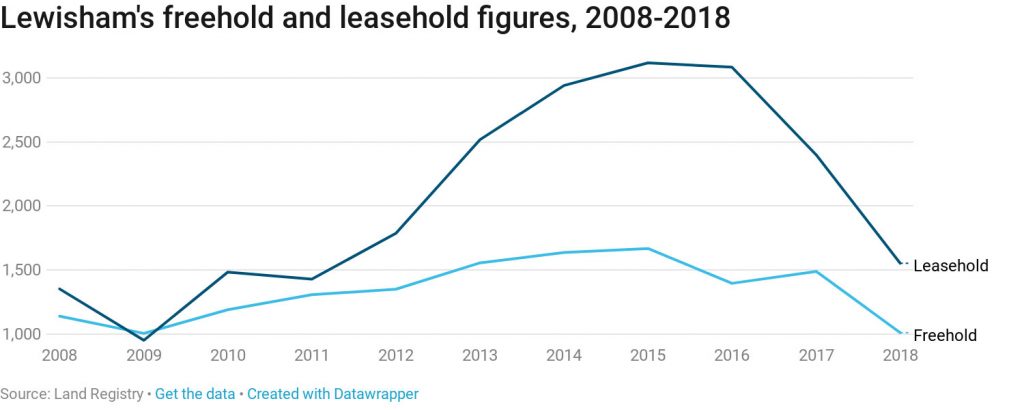
Graph: Sam Hancock
But freehold property sales have dropped too. This year alone marks the borough’s lowest recorded freehold sales since 2009, meaning less people now own the homes they are buying.
Unlike Tower Hamlets, Hackney and Lewisham, less leasehold homes were sold in Croydon this year than freehold; out of 2,054 sales, over 60 percent were freehold.
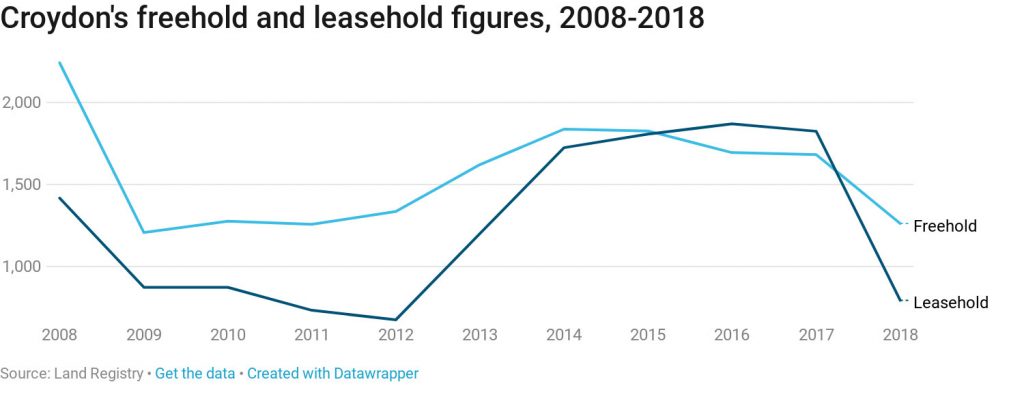
Graph: Sam Hancock
Yet, as Croydon continues to undergo its multi-million pound regeneration, which hopes to extensively improve the borough’s housing and transport, it is expected to see a similar decrease in freehold property sales as ELL’s other boroughs.
O’Kelly said “places like Croydon” will face difficulties when their new tower blocks, intended largely for residential use, are complete.
He said: “In places like Croydon, with leasehold, what you’re doing isn’t building homes, you’re creating tenancies and an asset – it’s a lucrative investment if you have a high ground rent and it’s not a home for those actually living in there.”



